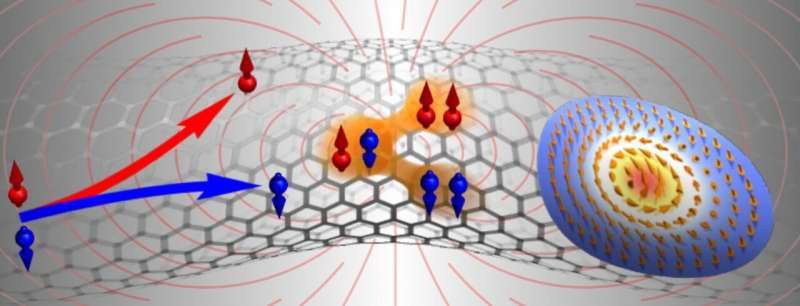Graphene scientists explore electronic materials with nanoscale curved geometries

In a recently published paper in Nature Electronics, an international research group from Italy, Germany, the UK, and China examined significant development directions in the field of electronic materials with curved geometries at the nanoscale. From microelectronic devices with enhanced functionality to large-scale nanomembranes consisting of networks of electronic sensors that can provide improved performance.
The scientists argue that exciting developments induced by curvature at the nanoscale allow them to define a completely new field—curved nanoelectronics. The paper examines in detail the origin of curvature effects at the nanoscale and illustrates their potential applications in innovative electronic, spintronic and superconducting devices.
Curved solid-state structures also offer many application opportunities. On a microscopic level, shape deformations in electronic nanochannels give rise to complex three-dimensional spin textures with an unbound potential for new concepts in spin-orbitronics, which will help develop energy-efficient electronic devices.
Curvature effects can also promote, in a semimetallic nanowire, the generation of topological insulating phases that can be exploited in nanodevices relevant for quantum technologies, like quantum metrology. In the case of magnetism, curvilinear geometry directly forges the magnetic exchange by generating an effective magnetic anisotropy, thus prefiguring a high potential for designing magnetism on demand.
Dr. Ivan Vera-Marun from the National Graphene Institute at The University of Manchester commented, "Nanoscale curvature and its associated strain result in remarkable effects in graphene and 2D materials. The development in preparation of high-quality extended thin films, as well as the potential to arbitrarily reshape those architectures after their fabrication, has enabled first experimental insights into how next-generation electronics can be compliant and thus integrable with living matter."
The paper also describes the methods needed to synthesize and characterize curvilinear nanostructures, including complex 3D nanoarchitectures like semiconductor nanomembranes and rolled up sandwiches of 2D materials, and highlights key areas for the future developments of curved nanoelectronics.
More information: Paola Gentile et al, Electronic materials with nanoscale curved geometries, Nature Electronics (2022). DOI: 10.1038/s41928-022-00820-z
Journal information: Nature Electronics
Provided by University of Manchester





















